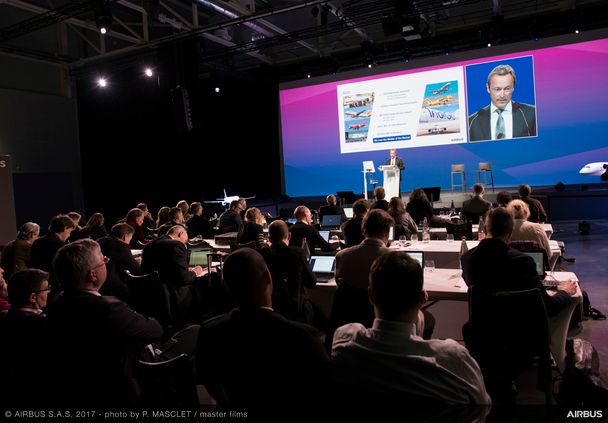A strong performance in 2016 positions Airbus Commercial Aircraft for the future

Airbus Commercial Aircraft enters 2017 on a strong competitive footing, having met the 2016 jetliner delivery goals and logging an order volume last year that exceeded the year’s target and raised backlog to a new industry record; all while positioning itself as a more efficient, innovative company offering a broader range of services to customers.
Fabrice Brégier, President of Airbus Commercial Aircraft, said the record of 688 aircraft deliveries in 2016 confirmed that the company's largest production ramp-up ever is “well and truly underway, and gathering momentum.” For new business logged during the year, the 731 net orders boosted overall backlog to a new industry record of 6,874 as of 31 December, representing approximately 10 years of production at current rates.
Speaking to reporters in Toulouse, France, Brégier said the 2016 results demonstrated how demand for Airbus aircraft is continuing to be strong, driven by a sustained growth in commercial air travel.
Airbus Commercial Aircraft is “stronger than ever”
“We are stronger than ever, and able to develop profitability,” Brégier told reporters at the Annual Airbus Commercial Press Briefing on 11 January. “Working on our backlog and delivering to our customers are among our priorities.”
Among the 2016 achievements cited by Brégier was the highest A320 Family aircraft production rate ever, reinforcing the competitive edge of this best-selling single-aisle jetliner product line with 545 deliveries last year. The 607 net orders logged during the 12 months were composed of 561 in the New Engine Option (NEO) version (bringing overall net NEO order intake to 5,069) and 46 for Current Engine Option (CEO) aircraft.
“The A321 – our largest single-aisle aircraft in the A320 Family – accounted for a bigger share of deliveries than ever before, as we delivered 222 of them last year,” he added. “This shows how the A321 has the so-called ‘middle of the market’ sewn up.”
An exceptional year for the A350 XWB programme
In widebody activity, Brégier highlighted the A350 XWB programme’s “exceptional year,” with Airbus delivering 49 A350-900s to 11 customers, booking net orders for 41 jetliners, and remaining on track to reach an output rate of 10 A350 XWBs per month by the end of 2018. The longer-fuselage A350-1000 is progressing well in flight testing utilising the no. 1 aircraft, now joined by a second A350-1000 which made its maiden take-off yesterday.
Airbus’ A330 jetliner remains very popular with customers: 83 aircraft were ordered in the New Engine Option and Current Engine Option configurations during 2016, with 66 delivered to customers – including the first A330 Regional variant.
Milestones for the A330neo version – the fastest aircraft development programme ever at Airbus – included the no. 1 aircraft’s rollout from the paint shop in late December.
Both Brégier and John Leahy, the Chief Operating Officer - Customers at Airbus Commercial Aircraft, said a market requirement continues for the double-deck A380. “As air traffic doubles every 15 years, our A380 is the best aircraft to capture peak demand, relieve airport congestion and boost hub operations,” Leahy told reporters. “We also see how the A380 enhances airlines’ brands, with passengers going out of their way to fly the aircraft.”
A total of 28 A380s were delivered during 2016, with production adjusting to a rate of 12 annually for a backlog that stood at 112 by year-end 2016.
Benefiting from integration; looking to harness digital technology
Looking to the future, Brégier said the company integration at Airbus will strengthen its position as an aerospace industry leader, reflecting an environment that is being re-shaped by tougher competition, the digital technology revolution and enhanced shareholder expectations.
“We made the decision to streamline our company by merging Airbus – the commercial aircraft manufacturing division – with Airbus Group, our parent company,” he explained. “The result will be a leaner, less complex organisation that is united under a single brand: ‘Airbus.’”
Included in Airbus’ future business focus is the commercial aviation services market, which could be worth some $3 trillion over the next two decades, Brégier noted. Airbus Services saw strong market demand in 2016 that fuelled a double-digit growing revenue stream across all business lines. “This is why Airbus looks to expand the range of services it offers, leveraging our innovative digital capabilities – especially in the predictive maintenance domain,” he added.
Brégier said the overall emphasis on digital innovation will remain a priority for the company, with Airbus becoming more systematic in using digital technology. “We must harness the revolution in digital technology,” he concluded. “This is our goal in 2017: in my dual responsibilities as the President of Airbus Commercial Aircraft and the Chief Operating Officer of Airbus, I will be in the driver’s seat for this.”
For additional information on the 2016 Airbus Commercial Aircraft results:
· Read the year-in-review press release
· Watch the annual press conference replay and download the presentations.
